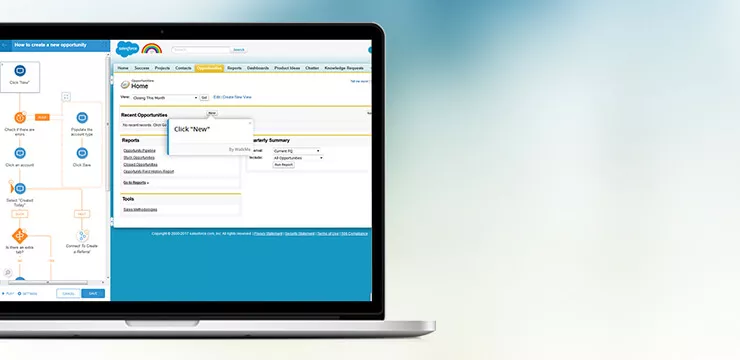Welcome to world of Salesforce! Whether you are choosing your organization’s first CRM or migrating from a different platform, as the leader of your organization’s Salesforce adoption there is a lot to consider.
This article includes high-level information and resources for getting started with Salesforce. You can expect an intro to Salesforce the company, key points of consideration, and more nuanced guides on getting started with Salesforce.
Salesforce is more intuitive and simple when using WalkMe’s step-by-step guidance.
An Introduction to Salesforce the Company
Salesforce is the world’s leading CRM platform, used by organizations to manage the customer funnel and pipeline. Once a customer is in the system as a lead, their entire relationship with the company can be logged and optimized within Salesforce.
Salesforce was founded in 1999 by Parker Harris, Dave Moellenhoff, Frank Dominguez and Marc Benioff who maintains his role as CEO today. The company is based in San Francisco and employs roughly 25,000 people. Salesforce went public in 2004 raising $110 million.
Salesforce holds the largest market share of all CRM platforms, including platforms on and off the cloud. Its success is largely attributed to the fact that it was (supposedly) the first to pioneer software as a service (SaaS) which allows customers easy implementation, low upfront costs, flexibility and accessibility throughout. As the first company born in the cloud it has dominated this space ever since.
Salesforce is also the reason for Dreamforce. This annual mega-convention saturates San Francisco with all things Salesforce, including the hundreds (or thousands?) of companies that exist entirely in the Salesforce ecosystem. The fanfare of Dreamforce demonstrate evidence of Salesforce’s impact and influence.
So, when you sit down to log into your Salesforce account, understand that you are logging into the most trusted, used, and supported platforms for managing your customers and data.
Try WalkMe today to effortlessly manage your customers and data on Salesforce.
Getting Started With Salesforce: Setting Up For Success
The success of Salesforce in your organization will depend on two factors: implementation and user adoption. If the system is not set up right, or is not used by your staff, you simply won’t see beneficial results.
Implementation
Salesforce implementation is technical but has a lot more to it than just coding. To implement Salesforce, you’ll need to understand your business process and how you want the team to work and which departments are you planning to work with your CRM.
After understanding your High Level Design (HLD) of the system you will need to combine these concepts with Salesforce best practices. This is best done with a certified Salesforce Admin.
Salesforce Admins will be able to deliver a strategic implementation that combines your HLD, with your business needs, Salesforce best practices and information systems, ensuring success for your business.
With all the resources available in the big wide world of Salesforce, you should be able to reach a solution that streamlines your business operations and improves your bottom line. If your implementation goes South, it’s hard to blame Salesforce. Makes sure you have the right talent onboard for smooth implementation.
User Adoption
The true value of Salesforce lies in its reports. But to get reports you have to have data, and data comes from the use of Salesforce. What this means is that your Salesforce users must take advantage of the full potential of the platform to get the highest ROI, and this is why user adoption is so important.
Training your staff to use the platform should be a top priority. There are a lot of free and paid online Salesforce training materials available from Salesforce. And a quick google search for Salesforce training will connect you to numerous companies and specialists who will train your staff how to use the CRM.
The problem with these training methods is that it takes your sales staff away from their revenue-generating roles. WalkMe’s Digital Adoption Platform (DAP) can be used to train employees while they work on Salesforce with step-by-step guidance. The DAP works in real time, on top of your Salesforce platform so that employees don’t have to switch between training and work.
But even at WalkMe, where we do use our own product, we still enforce user adoption with the rule: If it’s not in Salesforce, it didn’t happen. If you have closed a deal in Q2 but the date in Salesforce is Q3, you will get your commission in Q3 and not Q2.
When you are getting started with Salesforce, start a strong culture of making the most of the system to ensure successful user adoption.
Easily get started with Salesforce by using WalkMe’s onscreen support. Try it today for free.
Getting Started With Salesforce Guides
Finally, use these resources to understand the more granular parts of getting started with Salesforce. As mentioned before, there is an entire ecosystem of resources and support to help you along the way. Starting here, even before you make your decision to buy or migrate to Salesforce, will give you a better perspective on what is to come.
Understanding the Basic Building Blocks of Salesforce CRM
Get a quick look at how Salesforce aligns your sales and marketing teams to improve your bottom line.
Salesforce Online Training
With classes for every role, you’ll find resources for everyone to become experts of their [Salesforce] domain without ever leaving their desk.
Get Started with Salesforce
This regularly updated, 100+ page comprehensive guide will give you information on everything from definitions to technical how-to’s, printable tip sheets for each department and more. When you are serious about Salesforce this is your guide.
Getting Started: Salesforce Fundamentals for Nonprofits
Salesforce’s level of customization is an incredible asset. Use this guide to understand how the CRM can be customized for nonprofits.
5 Steps to Effective Lead Management
This article breaks down lead management starting with aligning sales and marketing and ending with how to track lead generation efforts.
Setting Up Customer Support
This guide is half technical guide, half checklist, to make sure your team is set up and ready to manage customer support.
6 Steps Toward Top Data Quality
Bad business data can lead to bad business decisions. This article will help you understand how to boost data quality.


